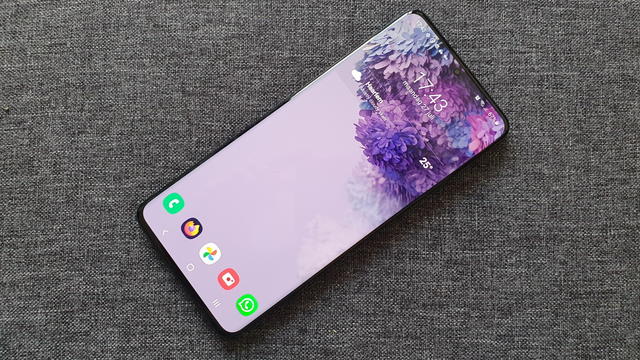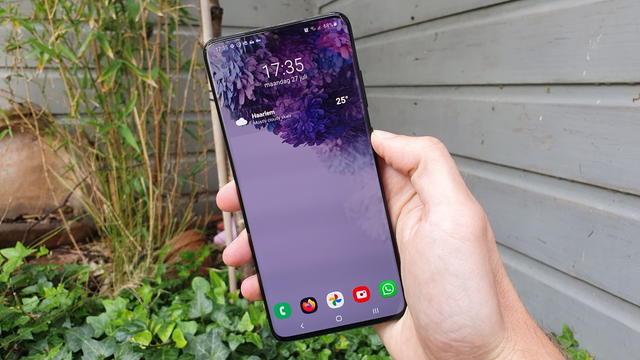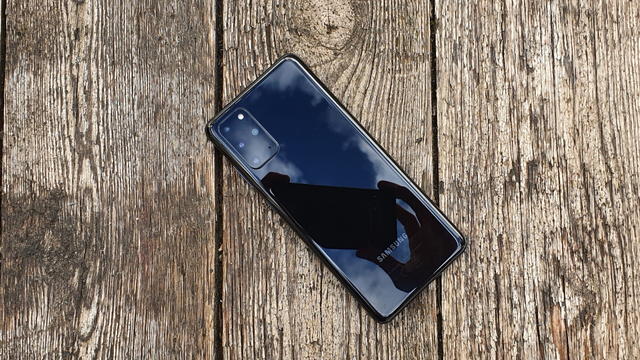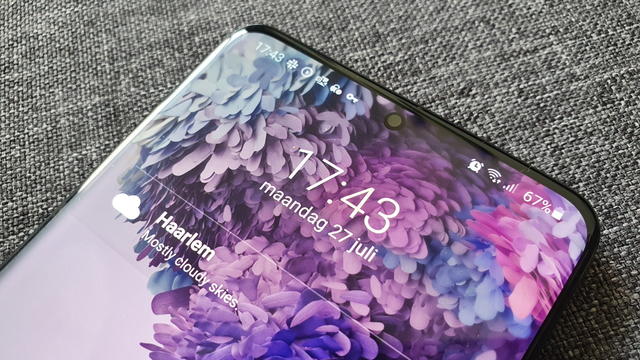
Although the Galaxy S20 smartphone series has been out for a while, most of the attention has been on the Galaxy S20 Ultra. You would almost forget that there is also a regular Galaxy S20 and a Galaxy S20 +. Both smartphones are priced a lot more accessible. You can read in this review whether the Samsung Galaxy S20 + is also worthwhile.
Samsung Galaxy S20 +
price € 749, –
Color Gray, blue, black
OS Android 10 (OneUI)
Screen 6.7 inch amoled (3200 x 1440, 120 hertz)
Processor 2.7 Ghz octacore (Exynos 990)
RAM 12GB
Storage 128GB (expandable with memory card)
Battery 4,500 mAh
Camera 64, 12, 12 megapixels (rear), 10 megapixels (front)
Connectivity 5G, Bluetooth 5.0, WiFi, GPS, NFC
Format 16.2 x 7.4 x 0.8 cm
Weight 186 grams
Other dual sim or memory card, fingerprint scanner under screen, depth camera
Website www.samsung.com/uk
8 Score 80 
- Pros
- Screen
- Cameras
- Performance
- 5G support
- Negatives
- Energy consumption somewhat high
- No headphone port
- price
- Bloatware
The Plus variant of the Galaxy S20 comes in two variants: one with 5G and one without. At the time of writing, 5G is just being rolled out. By opting for the more expensive version with 5G, you have a future-proof device. However, it will be a few more years before 5G really makes a big difference, when other bandwidths become available. The 5G version is not yet of great added value. Keep this in mind before you choose a more expensive smartphone and subscription for 5G.
The Galaxy S line has been Samsung’s top line for years, with prices being transferred annually from Apple. That is not the only thing that has been taken over from Apple in the last series: the cameras are incorporated in a rectangle at the back like the iPhone 11 (Pro) and the headphone port has to give way (also without any sensible reason).




Subtle bend
Furthermore, the appearance is unmistakably from Samsung. The screen fills the entire front, using curved screen edges to achieve that. A plus is that Samsung has managed to get the curved screen edges so small that you no longer accidentally touch them when using them. The front camera is also placed in a hole at the top of the screen. Not fancy, but it prevents the need for an edge or a screen notch in the top edge.
That screen is again a pearl to look at. Samsung makes the screens for many other smartphone manufacturers, such as Apple and OnePlus, but the company seems to be reserving the best screen panels for itself. Of course, the calibration of such a screen is also important, with Samsung invariably saturating the colors a little. The large 6.7-inch AMOLED screen has a 1440p resolution and a high refresh rate of 120 hertz to make the image run smoother. If desired, you can reduce that in the settings to a 1080p resolution and 60 hertz refresh rate to significantly increase the battery life.

Energy consumption
And the battery life, that is a part that you have to take into account. On paper, the battery capacity of 4,500 mAh should be more than enough for the smartphone to last about a day and a half. Nevertheless, the battery life is slightly lower in practice. You will get through the day with it, although that of course depends on your use. The Exynos chipset (own-made) that Samsung used in the S20 series does not appear to be the most economical and the choice for this chipset has given the company some criticism. The mobile internet connection in particular consumes above average, so those who are often on the road will notice that the battery drains faster. Especially if the screen is on at 120 hertz and 1440p resolution. You can charge the battery wirelessly and in the box you will find a 25-watt fast charger (with a USB-C to USB-C cable).
Exynos chipset
The criticism about the chipset was not limited to energy consumption. Performance would also be inconsistent. I did not notice this during testing. The S20 + performs excellently in both the benchmarks and in practice. The only hiccups that you sometimes notice in practice can be traced back to the drastic Android skin that Samsung uses. But in practice it should not have a name, the OneUI skin runs smoothly.
Because of course, the Galaxy S line from Samsung is the showpiece of the brand. Of course, the performance and specifications are excellent. The 12 GB of RAM contributes to this. You also have 128GB of storage at your disposal, which you can expand with a memory card if desired.

Cameras
Samsung has a good reputation when it comes to the cameras with which they equip their top smartphones, both the Galaxy S and the Galaxy Note series. But the competition is not standing still either. A year ago, Huawei had placed the best camera on the Huawei P30 Pro, which captures an impressive amount, especially in dark situations. Apple has also caught up, with the iPhone 11 Pro having a regular, telephoto and wide-angle lens. Now that is not so special on paper. But where the iPhone 11 Pro trumps the others is that the wide-angle and telephoto lens do not deliver visibly less good photos. Other smartphones, including last year’s Galaxy S10 +, also offer these three lenses. But when you switch from the regular lens, you notice that the photo is of lower quality.
It is precisely on that point that Samsung has made improvements to the Galaxy S20 +. The regular camera can still take better photos than the telephoto and wide-angle lens. But the differences are small. You no longer have to consider whether switching to the wide angle or zoom lens is worth the quality loss. A very nice plus! In addition to the three lenses on the back, you will also find a depth camera, which makes it possible to take better photos with a depth of field effect. Thanks to this effect you can blur the foreground or background. Night mode has also improved considerably compared to last year’s Galaxy S10 +, although it has yet to recognize its superiority in the unprecedented good night mode of Huawei’s top smartphones. All that’s missing is a periscopic camera that offers deeper zoom capabilities. This is reserved for the slightly more expensive Galaxy S20 Ultra.
You can still go to Samsung’s top smartphones if you want to shoot the best photos. Compared to the iPhone 11 Pro, the photos are slightly more exaggeratedly colored. The iPhone is usually more true to life, while the photos of the Galaxy S20 + are more vivid. The Samsung camera also knows better how to handle difficult lighting conditions, such as backlighting and photos with both dark and exposed surfaces. However, the depth of field of the iPhone is again ahead of the Galaxy S20 +.



From left to right: zoom lens, regular lens, wide angle lens. All three cameras provide equivalent photos.
Android 10 with OneUI
As has always been the case, Samsung is making quite a few changes to the Android 10 operating system with its own Androidskin OneUI. The appearance is unmistakably from Samsung and everything looks consistent. Still, Samsung adds just a bit too much, so that you often have to search in the settings screen and you are stuck with many Samsung services that you most likely never use. Like the Bixby Assistant, although it is a positive mention that Samsung has finally removed the disturbingly unnecessary Bixby button.
More annoying is that you are stuck with bloatware for a device in this price range. You will receive all Facebook and Microsoft apps installed for you unsolicited, and in the settings you will find a McAfee virus scanner that is not only unnecessary, but also irremovable. Samsung, like other Android manufacturers, also has a lot to do when it comes to Android and security updates. The promise to keep updating for two years must be improved. Especially if you dare to take over the prices from Apple, then as a brand you also have to improve the support duration.
The really more interesting alternatives to the Galaxy S20 + can be found in the lower price ranges.
Alternatives to the Samsung Galaxy S20 +
Of course, Samsung itself supplies alternatives to the Galaxy S20 + with the Galaxy S20 series. For example, the S20 Ultra has an even larger screen, periscope camera and more battery capacity. But you pay a lot more for that. More interesting is actually the regular Galaxy S20. This one is priced a bit more friendly and is less exaggerated. Only the camera depth sensor is missing and the battery capacity is less high.
Because Samsung has set the price so high, the S20 + still falls into the ‘buy an iPhone’ price range. Not because the iPhone 11 or iPhone 11 Pro are better, but thanks to Apple’s support, you do have a more future-proof smartphone. The 5G support may be in the advantage of Samsung, but before 5G really makes a difference, we are years on.
The really more interesting alternatives to the Galaxy S20 + can be found in the lower price ranges. Here you can find comparably good smartphones. The Pocophone F2 Pro, for example, has a better battery life and 3.5mm port, but 5G is missing and the software shell is lousy. The OnePlus Nord also offers a lot for a lower price tag: a better Android skin and support. Both devices do compromise on photo quality.
Conclusion: buy Samsung Galaxy S20 +?
The Galaxy S20 + is definitely a top phone. The performance is impressive, the cameras are versatile and all-round good and that screen is nothing short of fantastic. Moreover, you are probably ready for the future thanks to 5G support. Nevertheless, you can expect more in the software field for this price. The amount of unnecessary apps and services is simply too high and you can also expect Apple-like update support for an Apple-like price.
.